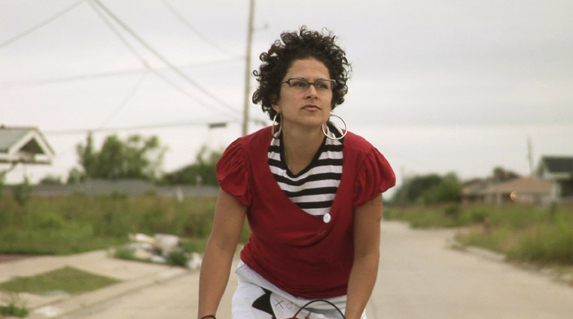The feature documentary Herman’s House brings together two disparate worlds: that of 35-year-old New York City artist Jackie Sumell and 69-year-old Herman Wallace, serving a life sentence in the Louisiana State Penitentiary—40 of which have been in solitary confinement.
The film opens to a dark screen and with the voice of Wallace describing his home: a 6-by-9 foot cell in which he spends 23 hours a day and can move only four feet in one direction. “I’m used to it, and that’s one of the bad things about it,” he says.
In a terrific choice, first-time director Angad Bhalla never shows Wallace. The impact of his invisibility is an added layer of the film—it’s a profoundly accurate portrayal of the many lives that most people in the “free world” don’t know about, think about, or much less see. The disembodied voice of Wallace, interrupted by the audio recording “This is a call originating from a correctional facility” exposes a world that cannot be fathomed. Indeed, the fact that he has access to a phone and to someone on the outside, and thus a platform, is in itself an anomaly.
Somewhat jarringly, as their lives could not be more different, the film examines how the two intersect through Sumell’s art project, and this is what the film is about, for better or worse. The film uncovers tantalizing tidbits of Wallace’s life: He was convicted in 1967 of bank robbery (which he acknowledges is true) and in 1972 of murdering a prison guard (which he denies). Although his past is acknowledged, it’s not explored in any depth. Aspects of Sumell’s life and history are also captured along with a few well chosen interviews of people positively influenced by Wallace.
Sumell began a correspondence with Wallace in 2001, and at one point she asked him, “What kind of house does a man who has lived in a 6-by-9 cell for over 30 years dream of?” After five years (with a break during her mother’s bout with cancer), her exhibition opened, featuring a full-scale model of his cell and detailed plans of his dream home. In another strange turn, Sumell embarks on making his dream house a reality, with the thought that it will be a center for wayward youth until Wallace’s hopeful release. Strange, not so much in the fact that Wallace may never be released, but in how exactly a bedroom with a mirrored ceiling and a prison cell-like room will be useful to youth.
Questions arise, such as: What is the point? The same could be asked about art and life. Clearly art is engaging Wallace with the outside world in a way that has got to be sanity saving, yet the extreme polarity from the affluence of the New York City art scene with wine, cheese, high-strung people and the ability of Sumell to pursue this dream (including moving to New Orleans to look for property, etc.) creates a different type of angst, at least in this viewer’s experience. What is the intersection between art and life? How do the poverty class and the affluent connect? There are no answers, just lots to talk about after the credits roll.
More than 2.2 million people are incarcerated in the US, and roughly 80,000 in solitary confinement. Some, such as Wallace himself, may be innocent of the charges that have landed them there. Regardless of their guilt or innocence, many civilized nations consider 23 hours in a solitary cell torture, cruel and unusual punishment. While the film doesn’t delve deeply into legal, moral or other issues around solitary confinement, it will bring the issue to light for a younger generation of artists and activists. Amy Cheney, Librarian, Alameda County Library, Juvenile Hall, San Leandro, CA







Leave A Comment